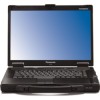Panasonic Toughbook 52 Mapping Technical and Operational Challenges of Mobile - Page 5
Commercial-grade, Business Rugged, Semi-Rugged, Fully Rugged - prices
 |
View all Panasonic Toughbook 52 manuals
Add to My Manuals
Save this manual to your list of manuals |
Page 5 highlights
Advancements in the technology around ruggedness have led to the creation of smaller, lighter devices. In addition, today's offerings incorporate most of the current standards-based components and frequently lead with the integration of next generation functionality such as wireless communications. Finally, recognizing the limitations of two defined categories of commercial-grade and rugged, vendors have expanded the levels of ruggedness to map better to various workforce requirements. Categories now include: • Commercial-grade: The most common type of enterprise notebook, commercial-grade, indicates no official rugged specifications. Commercial-grade notebooks provide levels of consistency and support that consumer grade devices do not strive to match. The production of these units is usually outsourced to an OEM to keep costs low. • Business Rugged: These notebooks generally feature no official specifications (although some do map to existing standards for rugged notebooks), but in recognition of the increasing importance of durability, vendors have created solutions with specialized/metal casing, shock-mounted hard drives, spill-proof keyboards, other reinforcements to protect against drops and spills and integrated mobile broadband radios. The result is a blended platform that features a premium price point that can survive semi-hazardous, non-carpeted environments. • Semi-Rugged: The traditional semi-rugged notebook is not designed for use in severe conditions but features some of the reinforcements of ruggedness such as metal casing, spill resistance and sealed ports, daylight viewing technology, and shock absorption reinforcement such as rubberized bumpers and internal dampers. • Fully Rugged: Created for the most hazardous environments, these notebooks feature a specification of IP-54 or greater, comply with relevant MIL-STD-810F environmental tests and are constructed with the most sophisticated technologies for antenna pass-throughs, casing and reinforcements. These systems are often UL-1604 certified, allowing them to be used in hazardous environments such as oil and gas. A sub category of fully rugged is ultra-rugged computers (at least IP-64, fully sealed with MIL-STD-461E specification). Highly mobile workers operating outside of the carpeted office space who support applications deemed mission critical to business operations should consider some level of a rugged device. Frankly, a majority of office bound users are served best by the commercial-grade device. Yet, segments of the enterprise space could experience cost savings by adopting a higher degree of ruggedness. Highly mobile workers operating outside of the carpeted office space who support applications deemed mission critical to business operations should consider some level of a rugged device. A TCO analysis, conducted to properly account for the operational costs of mobile computing, can help quantify the cost benefits. © 2009 VDC Research Group, Inc. 4














